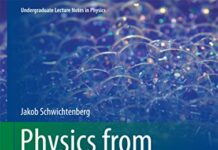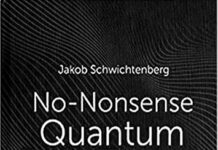
Ebook Info
- Published: 2018
- Number of pages:
- Format: PDF
- File Size: 8.48 MB
- Authors: Jakob Schwichtenberg
Description
Learning quantum mechanics doesn’t have to be hardWhat if there was a way to learn quantum mechanics without all the usual fluff and mystification? What if there were a book that allowed you to see the whole picture and not just tiny parts of it?Thoughts like this are the reason that No-Nonsense Quantum Mechanics now exists.What will you learn from this book?Get to know the fundamental quantum features — grasp how different nature works at the level of elementary particles.Learn how to describe quantum mechanics mathematically — understand the origin and meaning of the most important quantum equations: the Schrödinger equation + the canonical commutation relations.Master the most important quantum systems — read step-by-step calculations and understand the general algorithm we use to describe them.Get an understanding you can be proud of — learn why there are alternative frameworks to describe quantum mechanics and how they are connected to the standard wave description.No-Nonsense Quantum Mechanics is the most student-friendly book on quantum mechanics ever written.Here’s why.First of all, it’s nothing like a formal university lecture. Instead, it’s like a casual conservation with a more experienced student. This also means that nothing is assumed to be “obvious” or “easy to see”.Each chapter, each section, and each page focuses solely on the goal to help you understand. Nothing is introduced without a thorough motivation and it is always clear where each equation comes from.The book contains no fluff since unnecessary content quickly leads to confusion. Instead, it ruthlessly focuses on the fundamentals and makes sure you’ll understand them in detail.The primary focus on the readers’ needs is also visible in dozens of small features that you won’t find in any other textbookIn total, the book contains more than 100 illustrations that help you understand the most important concepts in visually.In each chapter, you’ll find fully annotated equations and calculations are done carefully step-by-step. This makes it much easier to understand what’s going on. Whenever a concept is used that was already introduced previously there is a short sidenote that reminds you where it was first introduced and often recites the main points. In addition, there are summaries at the beginning of each chapter that make sure you won’t get lost.
User’s Reviews
Reviews from Amazon users which were colected at the time this book was published on the website:
⭐Buen libro. Muy agradable de leer y muy entendible. Si quieres aprender teoría cuántica de campos, comience por aquí. Lo recomiendo.
⭐I spent years trying to gain an understanding of quantum mechanics. I had studied partial differential equations and understood them. I knew how to solve the wave equation. But what the wave equation represented and how it came to be was a mystery. I got the best books written on the subject that were recommended by phd’s in physics, but none explained what things meant. They all assumed you already knew.I posted the wave equation on the blackboard in my office determined to learn what it meant.Thanks to this book I understand it so well I can derive it in my head.I had also seen the term “symmetry” tossed around a lot without explanation until I read this book and now I understand what it is and why it is important.The reason a “ket” is the transposed complex cojugate of a “bra” is now crystal clear. These are just a few examples of what I personally got out of this book.Schwichtenberg does a great job of illuminating this subject and I have or will purchase the rest pf his books on physics. He comes off very modest, but he has a deep understanding of the subject matter and the ability to explain things in a way that makes sense.The book is more about understanding and presents the basic problems but is not meant to be an in depth compendium of problems. I like this because it allows me to read the entire book at a reasonable rate without getting bogged down in arcane details of finite mathematics that won’t be memorized and can be looked up when needed to solve a problem.I still need to solve a lot of problems to become really good at quantum mechanics, but things are no longer mysterious.I highly recommend this book if you want just the facts to form a basis of understanding.I have to admit in college I decided to be a chemistry major in college after looking at a quantum mechanics textbook and being overwhelmed by the math and symbols. If you do not have the foundation in basic and vector calculus, linear algebra, ordinary and partial differential equations, and statistics you will become quickly lost. No-Nonsense Quantum Mechanics is a nice fast read of first semester quantum mechanics if you are comfortable with the noted math. I would have given the book five stars if there was an expanded treatment of the mathematical foundation. This could be easily added with additional appendices or perhaps in a separate book. It is best to learn this math in high school so that classical mechanics, electrodynamics, and quantum mechanics are not overwhelming in the beginning of college. If you are returning to these subjects later in life and you know and remember this math, this book is a wonderful read. (If you pick your books right you can learn this math on your own over six to twelve months. There are also some very good on line tutoring services if you need help.) Part 3 of the book is a nice discussion of different formulations of quantum mechanics and the philosophy of quantum mechanics. I was not familiar with the quote from Heisenberg,”space is blue and birds fly through it.” It is Spring and going to be beautiful today.This book mainly focuses on the general principles and most common methods used to solve quantum mechanics problems. Don’t expect it to teach you have to solve any specific problem – it won’t. Instead, read this book to get a good “bird’s eye view” of what it means to become involved in quantum mechanics.I’m not saying that this book is dumbed down – not at all. Every page is covered in equations. However, don’t let the “symbol soup” intimidate you too much. I haven’t done any calculus or linear algebra since college (over 25 years ago) and I was still able to follow most of this book. Every equation is derived by the author, and while I did not always fully understand each step, the author always included a plain text explanation of the meaning behind the equation, often with simple examples. There were several cases where I got lost in the math, but understood the meaning of the end result, and that was good enough for learning the principle the chapter was trying to teach.The writing was clear, the illustrations plentiful, and plenty of references are given if you wish to investigate specific areas further.I really liked the writing style of Jakob. He starts with an outline, giving the big picture, dives into the details, and surfaces the important points again in the end. The basic intuition is emphasized but rigor is not compromised, so I was able to come away with a good understanding of quantum mechanics.There are a lot of illustrations and footnotes to guide the reader along the way. Important points are often repeated subtly so that even if the reader jumps around they will not get lost in the details.The book really lives up to its name and is no nonsense, student friendly.This book is very well written and a pleasure to read. I especially appreciated the chapters on alternative formulations of quantum mechanics, a subject that is usually neglected by other books, and the chapter introducing perturbation theory.When the book arrived in the mail I was surprised that it was thinner than the classical mechanics book of the same series. Based on my experience with the Theoretical Minimum books by Susskind, I expected the QM book to be about twice the size of the CM book. The reason for the low page count of this book is that it does not cover multi-particle systems and entanglement. This is too bad because entanglement is a key feature of QM! I hope that the author will add a chapter or two on this subject in the next edition; then the book deserves 5 stars!Best introduction to QM.I particularly like the way this book arrives at the time-dependent Schrodinger equation, as opposed to other books which effectively say “Here’s the solution, now let’s find the equation”Jakob Schwichtenberg hat auf dem Gebiet der Physik promoviert, ist Mitarbeiter am Institut für Technologie der Universität Karlsruhe, Autor von ‘Physics from Symmetries‘ (Springer) und Herausgeber der No-Nonsense Buchreihe, die das Ziel verfolgt, Studenten freundliche wissenschaftliche Text zu veröffentlichen – insbesondere zur Physik.Mit dem vorliegende Buch, präsentiert der Autor seine No-Nonsense Variante der Quantenmechanik. Wie er im Vorwort erörtert, ist die Zahl der Lehrbücher zu diesem Thema zwar Legion, aber dieses ist insofern einzigartig, da es sich strikt auf die Grundlagen konzentriert, und dabei versucht, so Studenten-freundlich wie möglich zu sein.Der Autor beginnt mit einem Blick aus der Vogelperspektive auf die wesentlichen Konzepte der Quantenmechanik, die sich so drastisch von denen der klassischen Physik unterscheiden, danach wird das Quanten Framwork eingeführt und ohne viel Federlesen besprochen, dazu gehören Zustandsvektoren (in Ket Schreibweise), Operatoren, die Informationen aus den Zuständen extrahieren, Eigenwerte und Eigenvektoren, Erwartungswerte und die statistische Interpretation von gemischten Zuständen, d.h. die Bornsche Regel für Zustandsamplituten. Wellenfunktionen sind Darstellungen von Zustandsvektoren, die nach der Positionsbasis entwickelt wurden. Die grundlegenden Operatoren der Quantenmechanik, etwa für Impuls und Drehimpuls, werden durch Gruppenwirkungen motiviert und mit den Generatoren dieser Wirkungen in Beziehung gesetzt, die entsprechenden Kommutatorrelationen und Änderung von Zuständen, gemäß der Schrödinger Gleichung, erwähnt – allerdings werden die Erläuterungen hier schon recht vage. Aber man muss fairer Weise einwenden, dass die Quantenmechanik eben gerade nicht ‘ableitbar‘ ist, sondern einen radikal neuen Umgang mit ‘physikalischen Größen‘ darstellt, folglich sind ‘Sprünge‘ in Einführungen in die Quantentheorie unvermeidlich.Auf dieser Grundlage lassen sich einfache eindimensionale Probleme mit Topf-Potentialen mit Hilfe der Methode der Separation der Variablen explizit lösen. Die Behandlung des Wasserstoffatom deutet der Autor hingegen lediglich an, indem er die zugehörige Schrödinger Gleichung in Kugelkoordinaten formuliert. Die Energielevel eines Harmonischen Oszillator werden mittels Erzeugungs- und Vernichtungs- Operatoren ermittelt. Komplizierte Probleme lassen sich oft mit Störungstheoretischen Methoden behandeln, das wird am einfachsten Fall (zeitunabhängig, nicht entartet) demonstriert.Im letzten Teil des Buches werden einige fortgeschrittenere Themen skizziert. Dazu zählen alternative Formulierungen der Quantenmechanik: die Pilotwellen Formulierung von D. Bohm, die Methode der Pfadintegrale und die Heisenbergsche Formulierung. Ein abschließendes Kapitel ist den Fragen zur Interpretation der Quantenmechanik gewidmet; wobei Schwichtenberg konstatiert, dass die Quantenmechanik gar keiner Interpretation benötigt – er folgt also der ‘shut up and calculate‘ These, die David Mermin im Hinblick auf die Kopenhagener Deutung formulierte. Danach tauchen die fraglichen Probleme nur auf, wenn man Wellenfunktionen physikalische Realität zuspricht, das sieht der Autor aber schon durch den Umstand widerlegt, dass es alternative Formulierungen gibt, die keinen Bezug auf Wellenfunktionen nehmen – er folgt damit einer interessanten Idee, die Carlo Rovelli in dem Preprint ‘Space is blue and birds fly through it‘ formuliert. Ist eine Wellenfunktion nur ein mathematisches Konstrukt, so wird auch das sogenannte Messproblem als hinfällig betrachtet. Fragen zur Interpretation der Quantenmechanik sind immer wieder Anlass zur kontroversen Diskussionen, eine recht ausführliche Behandlung findet man etwa bei S. Weinberg ‘Lectures on Qunatum Mechanics‘, 2nd Ed., dessen Analyse verschiedener Interpretationen beginnt bei Erkenntnis, dass die Bornsche Regel nicht aus der quantenmechanischen Dynamik ableitbar ist.sDas Buch ist sicher als erste Einführung in das Thema geeignet, entsprechend dem Ziel der No-Nonsense Reihe, werden hier sämtliche Ableitungen und Rechnungen detailreich und mit allen Zwischenschritten wiedergegeben – da fallen auch einige kleine Fehler kaum ins Gewicht. Der recht elementare Zugang ist der Beschränkung auf fundamentalen Elemente der Quantenmechanik geschuldet. Aber darin liegt auch die Schwäche der Darstellung, dadurch bleiben aber wesentliche Aspekte in der Schwebe – obwohl Messungen am Beispiel von Spins mit Stern- Gerlach Anordnungen erörtert werden, wird nicht explizit herausgestellt, dass in der Quantenmechanik zwei Dynamiken am Werk, die Entwicklung eines Zustand gemäß der Schrödinger Gleichung und die Reduktion auf einen Eigenzustand bei einer Messung. Aber auch wichtige und instruktive Grundbeispiele fehlen, etwa die Berechnung des Spektrum von Drehimpulsoperatoren, die analog zum Harmonischen Oszillator mittels Creation / Annihilation Operatoren leicht möglich ist.Das Werk kann aber sicher als Ergänzung zur Lektüre eines der Standard Lehrbücher zur Quantenmechanik wertvolle Dienste leisten. Die recht ausführliche Bibliographie enthält eine Auswahl solcher Monographien, aber auch weiterführende Literatur zu Fragen der Interpretation und anderen fortgeschrittenen Themen. Der Index ist aber ausgesprochen mager ausgefallen.In den Text hat sich leider auch ein unschöner LaTeX Fehler eingeschlichen, beim Beginn eines neuen Parts werden die Seitenüberschriften nicht zurückgesetzt, so dass im neuen Teil, bis zum Anfang des ersten Kapitels, auf der linken Seite noch der Titel des vorigen Kapitels gedruckt wird.The first part of this book explains the main ideas of the wave formulation of quantum mechanics. The second part exemplifies those ideas through some basic examples. Lastly, the third part gives a brief overview of other formulations of quantum mechanics. As someone interested only in the fundamentals of quantum mechanics, I found this book fairly accessible, and easy to follow.The book has a none negligible amount of typos but they don’t distract too much. The author updates the books often so one can assume that those typos will improve with time. My main complain with the book lies on chapter 1 (which is only a few pages long). The exposition of that chapter can be improved considerably. Luckily, one can skip that chapter on a first reading. After reading the rest of the book, that chapter makes more sense but yet, i feel that the exposition could be improved.The challenge was hard: QM is not easy to deal with, therefore (especially at the beginning) the book is less linear than other books by the same author. However, it contains many clever ideas on how to propose and simplify such a fascinating but complex subject. Particularly valuable is the framing of the different theories in a big picture and the essential list of useful pointers to relevant books and papers.Otro título del autor de esta serie “No-nonsense” muy recomendable. Muy claro y didáctico. Recomendable sin dudarlo.
Keywords
Free Download No-Nonsense Quantum Mechanics: A Student-Friendly Introduction, Second Edition in PDF format
No-Nonsense Quantum Mechanics: A Student-Friendly Introduction, Second Edition PDF Free Download
Download No-Nonsense Quantum Mechanics: A Student-Friendly Introduction, Second Edition 2018 PDF Free
No-Nonsense Quantum Mechanics: A Student-Friendly Introduction, Second Edition 2018 PDF Free Download
Download No-Nonsense Quantum Mechanics: A Student-Friendly Introduction, Second Edition PDF
Free Download Ebook No-Nonsense Quantum Mechanics: A Student-Friendly Introduction, Second Edition


